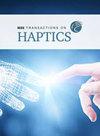用于结节检测训练的视觉-触觉系统:脑电图和行为分析的启示。
IF 2.8
3区 计算机科学
Q2 COMPUTER SCIENCE, CYBERNETICS
引用次数: 0
摘要
医学触诊是临床医生的一项关键技能。通常使用动物模型和合成模型进行训练,但这些模型会引发伦理问题,并产生大量消耗品。视觉触觉模拟是一种替代方法,尽管其训练效果尚未得到证实。触诊技能的评估需要客观的方法,这可以通过将性能指标与脑电图(EEG)相结合来实现。本研究的目标是(i) 结合 Geomagic Touch 触觉设备和皮肤斑块与结节的视觉触觉模拟,开发一套视觉触觉系统来训练结节检测,该系统使用 SOFA 框架实现;(ii) 评估该系统是否可用于训练和评估。为此,我们收集了 19 名受试者在多次重复执行结节检测任务时的表现和脑电图数据。结果显示,受试者可分为表现较差和表现较好的两类;前者在寻找结节时会施加较大的压力,并在休息时显示出较高的脑电图α(8.5 - 13 Hz)峰值;后者则会在皮肤表面进行探索,并表现出较低的α功率。此外,α功率与误差呈正相关,与触诊深度呈负相关。总之,这些结果表明,α 功率可能是成绩的一个指标,表示警惕性、注意力、信息处理、认知过程和参与度的提高,最终影响策略和成绩。此外,将脑电图与成绩数据相结合,可以客观地衡量用户的触诊能力。本文章由计算机程序翻译,如有差异,请以英文原文为准。
A Visuo-Haptic System for Nodule Detection Training: Insights From EEG and Behavioral Analysis
Medical palpation is a key skill for clinicians. It is typically trained using animal and synthetic models, which however raise ethical concerns and produce high volumes of consumables. An alternative could be visuo-haptic simulations, despite their training efficacy has not been proved yet. The assessment of palpatory skills requires objective methods, that can be achieved by combining performance metrics with electroencephalography (EEG). The goals of this study were to: (i) develop a visuo-haptic system to train nodule detection, combining a Geomagic Touch haptic device with a visuo-haptic simulation of a skin patch and a nodule, implemented using SOFA framework; (ii) assess whether this system could be used for training and evaluation. To do so, we collected performance and EEG data of 19 subjects performing multiple repetitions of a nodule detection task. Results revealed that participants could be divided in low and high performers; the former applied a greater pressure when looking for the nodule and showed a higher EEG alpha (8.5 – 13
$\mathrm{Hz}$
求助全文
通过发布文献求助,成功后即可免费获取论文全文。
去求助
来源期刊

IEEE Transactions on Haptics
COMPUTER SCIENCE, CYBERNETICS-
CiteScore
5.90
自引率
13.80%
发文量
109
审稿时长
>12 weeks
期刊介绍:
IEEE Transactions on Haptics (ToH) is a scholarly archival journal that addresses the science, technology, and applications associated with information acquisition and object manipulation through touch. Haptic interactions relevant to this journal include all aspects of manual exploration and manipulation of objects by humans, machines and interactions between the two, performed in real, virtual, teleoperated or networked environments. Research areas of relevance to this publication include, but are not limited to, the following topics: Human haptic and multi-sensory perception and action, Aspects of motor control that explicitly pertain to human haptics, Haptic interactions via passive or active tools and machines, Devices that sense, enable, or create haptic interactions locally or at a distance, Haptic rendering and its association with graphic and auditory rendering in virtual reality, Algorithms, controls, and dynamics of haptic devices, users, and interactions between the two, Human-machine performance and safety with haptic feedback, Haptics in the context of human-computer interactions, Systems and networks using haptic devices and interactions, including multi-modal feedback, Application of the above, for example in areas such as education, rehabilitation, medicine, computer-aided design, skills training, computer games, driver controls, simulation, and visualization.
 求助内容:
求助内容: 应助结果提醒方式:
应助结果提醒方式:


